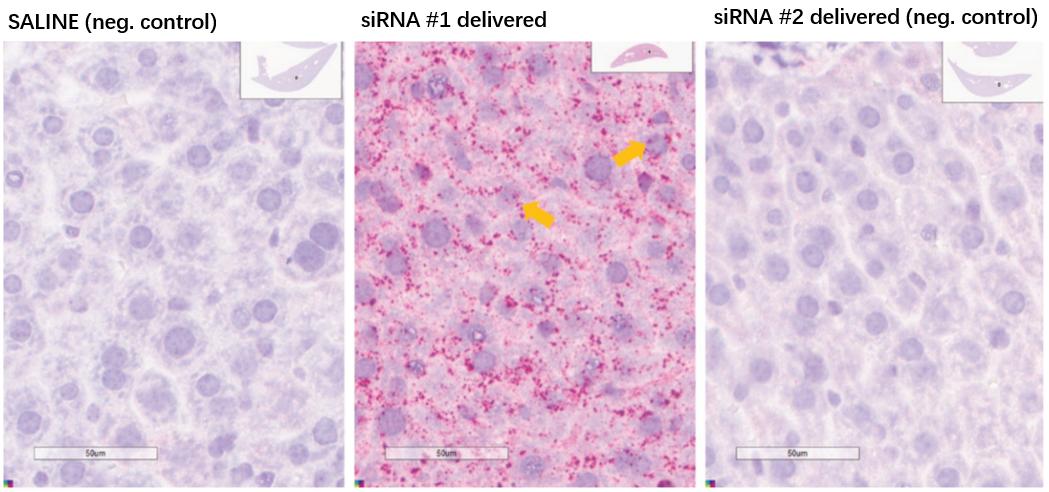CONTACT SUPPORT
Online Inquiry
The RNA ISH assay from Creative Bioarray can visualize and monitor the delivery and biodistribution of these synthetic RNA molecules to access the specificity and efficacy of these therapies. We can visualize gene (Target mRNA) regulation with morphological context using the RNA ISH method. Our siRNA/ASO/Target mRNA Biodistribution Analysis services can help validate and accelerate your gene therapy development.
RNA ISH assay allows the direct visualization of siRNA/ASO/Target mRNA in cells and tissues, providing spatial and temporal information on their distribution. This can help in understanding the cellular and tissue-specific uptake and localization of the molecules. RNA ISH assay offers valuable advantages in siRNA/ASO/Target mRNA biodistribution analysis, including visualization, sensitivity, specificity, quantification, multiplexing, and compatibility with other techniques.
 Figure 1. The targeting siRNA was detected using the siRNA probe in the siRNA-treated mouse liver tissue samples and not in the vehicle tissue samples using the RNA ISH assay, indicating successful delivery of the siRNA-based therapy. Expression of target mRNA was detected using the RNA ISH assay and appeared significantly reduced in the siRNA-treated tissue compared to vehicle-treated tissue suggesting successful knock-down of the target mRNA expression with the siRNA-based therapy.
Figure 1. The targeting siRNA was detected using the siRNA probe in the siRNA-treated mouse liver tissue samples and not in the vehicle tissue samples using the RNA ISH assay, indicating successful delivery of the siRNA-based therapy. Expression of target mRNA was detected using the RNA ISH assay and appeared significantly reduced in the siRNA-treated tissue compared to vehicle-treated tissue suggesting successful knock-down of the target mRNA expression with the siRNA-based therapy.
 Figure 2. Example of specific detection of the siRNA#1 probe (yellow arrows) in siRNA#1 treated mouse liver tissue samples only and not in the negative saline nor siRNA#2 treated samples indicates successful delivery of siRNA therapy and specificity of the miRNA ISH Assay. Biodistribution of siRNA target is also observed in the siRNA#1 treated samples.
Figure 2. Example of specific detection of the siRNA#1 probe (yellow arrows) in siRNA#1 treated mouse liver tissue samples only and not in the negative saline nor siRNA#2 treated samples indicates successful delivery of siRNA therapy and specificity of the miRNA ISH Assay. Biodistribution of siRNA target is also observed in the siRNA#1 treated samples.
Antisense oligonucleotides (ASOs) and small interfering RNAs (siRNAs) are the two most widely used strategies for silencing gene expression. The development of oligonucleotide therapeutics (OTs), including ASOs and siRNAs, has been remarkable in terms of therapy for diseases that cannot be treated with traditional medications. To date, there are 11 marketed products based on antisense oligonucleotides, aptamers and small interfering RNAs, and many others are in the pipeline for both academia and industry.
However, for the use of therapeutic ASOs and siRNAs, achieving sufficient productive uptake has become one of the biggest challenges and numerous ways to overcome this has been proposed. One approach is delivery in different types of formulations like the lipid nanoparticle (LNP) used to deliver. An alternative way to improve the productive uptake is conjugation of the oligo to a targeting ligand, utilizing binding to cell surface receptors that internalize the oligo conjugate.
The siRNA/ASO distribution can change with other administration routes and delivery systems like conjugates or formulations, so understanding the productive uptake distribution for such new conditions is critical for proper risk assessment of potential on- and off-target toxicities.
(1) Detect and identify cellular subtypes
(2) Synthetic RNA molecule Biomarker analysis
(3) Custom probes designed within 1-2 weeks
(4) Fastest turnaround time
(1) Detect and identify cellular subtypes
(2) Visualize gene regulation with morphological context
(3) Validate miRNA biomarkers in intact tissues
(4) Assess small RNA therapeutic delivery mechanism
(5) Evaluate biodistribution and efficacy of therapy
(6) Add a visual dimension to heterogeneous tissue biology and analysis
Our customer service representatives are available 24hr a day! We thank you for considering Creative Bioarray as your siRNA/ASO/Target mRNA Biodistribution Analysis partner.
References